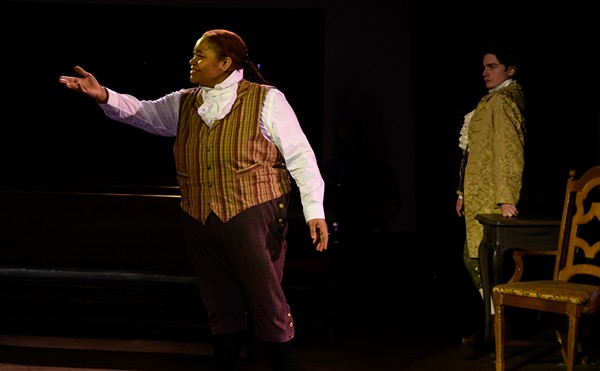Dreams mix the imagery of waking experience with a hint of the infinities that surround us, out in the dark beyond. In her second solo show at William Busta Gallery, titled Mystery Hatch, Cecelia Phillips shows 15 oil paintings executed in a loosely realistic style on canvas and paper. Most are dreamlike visions focused on animals or objects in a state of metamorphosis, headed toward death or decomposition or depicted in the aftermath of an event that has altered their integrity, partially translating them into a new context.
Two works show the severed heads of a sheep and a deer as in Renaissance nature morte paintings, meditating on the strange liveliness of dead things. Among the deceased invoked here are the past lives of painting itself, superimposed on contemporary preoccupations. "After Vermeer" derives from one of the Flemish master's vivid small portraits known as "The Wrightsman" or "Study of a Young Woman," chosen by Phillips partly for the differences between it and the similarly composed, more famous "Girl With a Pearl Earring." In the original, the young woman has a hard-to-define strangeness, as she gazes directly at us with a thin smile, turning from a fathomless dark background. In Phillips' work on paper, that magical darkness has crept further into the girl, changing her and emphasizing the un-cinematic quality of her face; in terms of pop culture, this is the "other" to Scarlett Johansson's more accessible "self."
Sea changes are everywhere at Mystery Hatch, which takes that title from an enigmatically lovely, nearly abstract work in which an incandescent, glowing area sweeps downward and fades into warm gray shadows. The light emanates from behind two dark, angled shapes, and above them at the top of the canvas, ambiguous green strokes like out-of-focus leaves stretch over richly varied indigo. We could be looking at a "hatch" opening either in a clearing or in mid-air, something like a scene from the TV series Lost. Metaphorically, the ambiguity of this image opens the door to the alternate dimensions of fantasy and reverie that Phillips explores.
Particularly surprising and successful is "Exploded Shed," showing the aftermath of a blast that splintered one end of a long, garage-like white structure. Siding peels away from the middle of the building in strips, curving out almost organically — a little like jaws or tentacles. "Albatross" depicts a compact station wagon stranded in a misty swamp or marsh. The bird, wings outspread, perches on its raised hood. Like the albatross in Samuel Taylor Coleridge's poem "The Rime of the Ancient Mariner," this portentous bird presides over a human thing becalmed and stranded in the seas of the imagination, tangled near some far shore of rebirth.













